Origin, insertion, innervation, action of skeletal muscles
1/49
Earn XP
Description and Tags
Name | Mastery | Learn | Test | Matching | Spaced |
|---|
No study sessions yet.
50 Terms
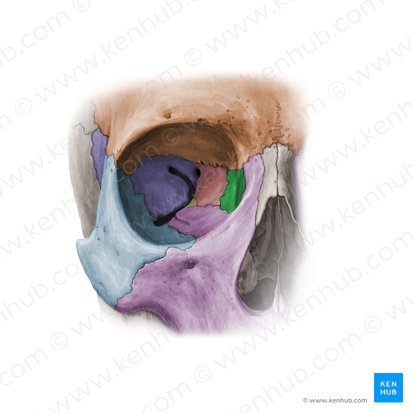
Name the muscle(s) that has their origin on the bone highlighted in green, including their:
insertion
innervation
action
orbicularis oculi
origin: lacrimal bone
insertion: upper and lower eyelids
innervation: facial nerve
action: closes eyelids
Name the muscle(s) that has their origin on the maxilla AND mandible, including their:
insertion
innervation
action
orbicularis oris
insertion: skin around lips
innervation: facial nerve
action: compression and pursing of lips
buccinator
insertion: angle of mouth
innervation: facial nerve
action: compresses cheeks, aids in mastication
Name the muscle(s) that has their origin on the zygomatic arch, including their:
insertion
innervation
action
zygomaticus major
insertion: angle of mouth
innervation: facial nerve
action: draws the angle of the mouth backward and upward
masseter
insertion: ramus of the mandible, coronoid process
innervation: trigeminal nerve
action: elevates mandible, closes jaw
Name the muscle(s) that has their origin on ONLY the mandible, including their:
insertion
innervation
action
mentalis
insertion: skin of chin
innervation: facial nerve
action: raises and protrudes lower lip
mylohyoid
insertion: body of hyoid bone
innervation: trigeminal nerve
action: elevates hyoid bone, depresses mandible
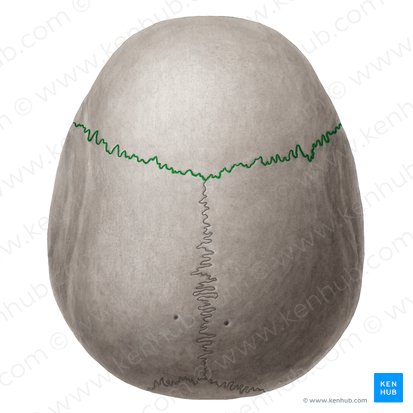
Name the muscle(s) that has their origin on the structure highlighted in green, including their:
insertion
innervation
action
frontalis
origin: coronal suture
insertion: skin of frontal region
innervation: facial nerve
action: wrinkles forehead skin, raises eyebrows
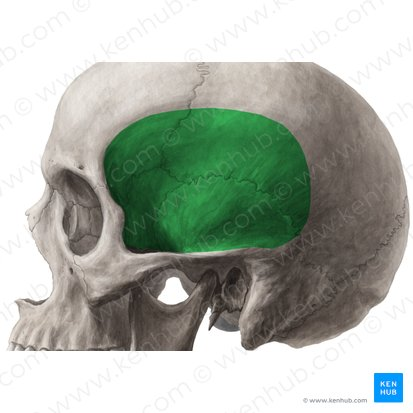
Name the muscle(s) that has their origin on structure highlighted in green, including their:
insertion
innervation
action
temporalis
origin: temporal fossa
insertion: coronoid process and ramus of mandible
innervation: trigeminal nerve
action: elevates mandible
Name the muscle(s) that has their origin on the mandible AND temporal bone, including their:
insertion
innervation
action
digastric
insertion: body of hyoid bone
innervation:
anterior: trigeminal
posterior: facial nerve
action: opens mouth by lowering mandible
Name the muscle(s) that has their origin on the manubrium and/or clavicle, including their:
insertion
innervation
action
sternohyoid
also has an origin on the medial end of the clavicle
insertion: body of hyoid bone
innervation: none
action: depresses the larynx and hyoid bone
sternothyroid
insertion: thyroid cartilage
innervation: none
action: depresses the larynx and hyoid bone
sternocleoidomastoid
also has an origin on the sternal head of the manubrium, and medial 1/3 of the clavicle
insertion: mastoid process of temporal bone, occipital bone
innvervation: accessory nerve
action: bilterally flexes head, unilaterally turns face toward opposite side
Name the muscle(s) that has their origin on the spinous processes of interior cervical vertebra and superior thoracic vertebra, including their:
insertion
innervation
action
splenius group
insertion: mastoid process of temporal bone, occipital bone
innervation: none
action: extending the neck, lifting head up
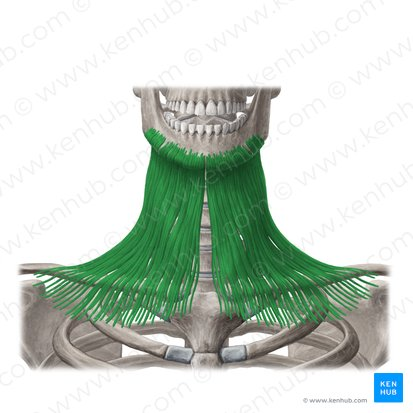
What muscle is highlighted in green? Where’s it origin and insertion? Also what innervation and action does it have?
platsyma
No origin or insertion
Innervation: facial nerve
Action: tenses skin of the neck
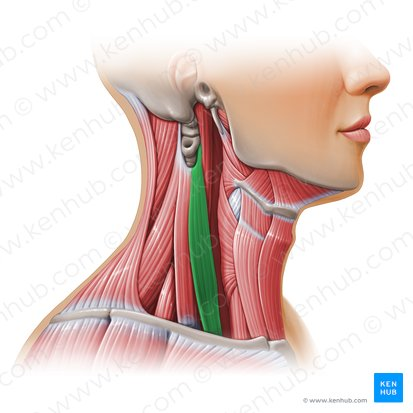
What muscle is highlighted in green? Where’s it origin and insertion? Also what innervation and action does it have?
scalene
no origin or insertion
Innervation: facial nerve
Action: both sides flex neck and elevates ribs
What muscles make up the erector spinae? What action do they all perform?
For each muscle of the erector spinae, what is its insertion?
Iliocostalis group: inserted at angles of lower ribs, cervical transverse processes
Longissimus group: inserted between tubercles and angles of ribs, transverse processes of thoracic and cervical vertebrae, and also the mastoid process
Spinalis group: inserted at the spinous processes of upper thoracic and mid cervical vertebrae
As a whole, these groups help extend and laterally bend the vertebral column and head
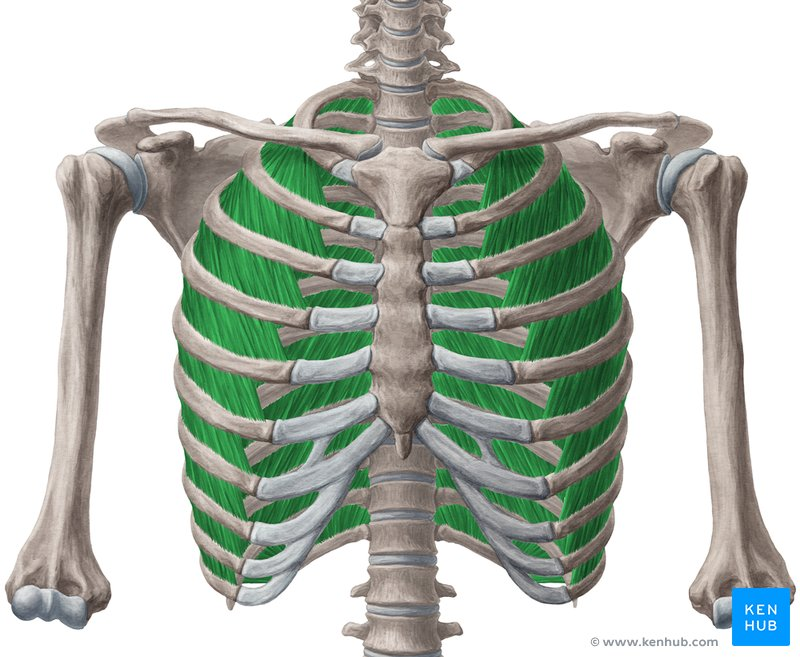
What muscle is highlighted in green? Where’s it origin and insertion? Also what innervation and action does it have?
External intercostals
origin: lower border of ribs
insertion: upper border of rib below rib of origin
innervation: intercostal nerves
action: elevates ribs in inspiration
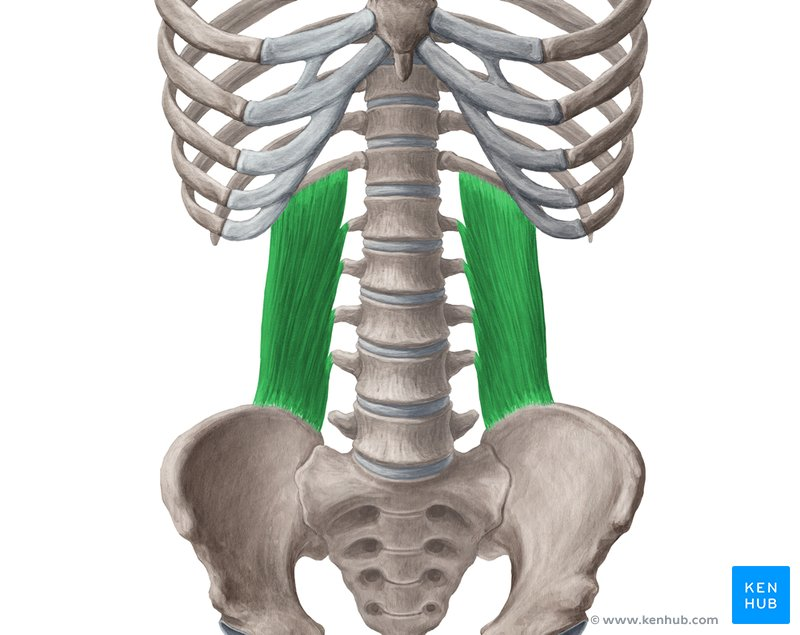
What muscle is highlighted in green? Where’s it origin and insertion? Also what innervation and action does it have?
Quadratus lumborum
origin: iliac crest
insertion: transverse processes of lumbar vertebra
innervation: none
action: extends and laterally flexes vertebral column
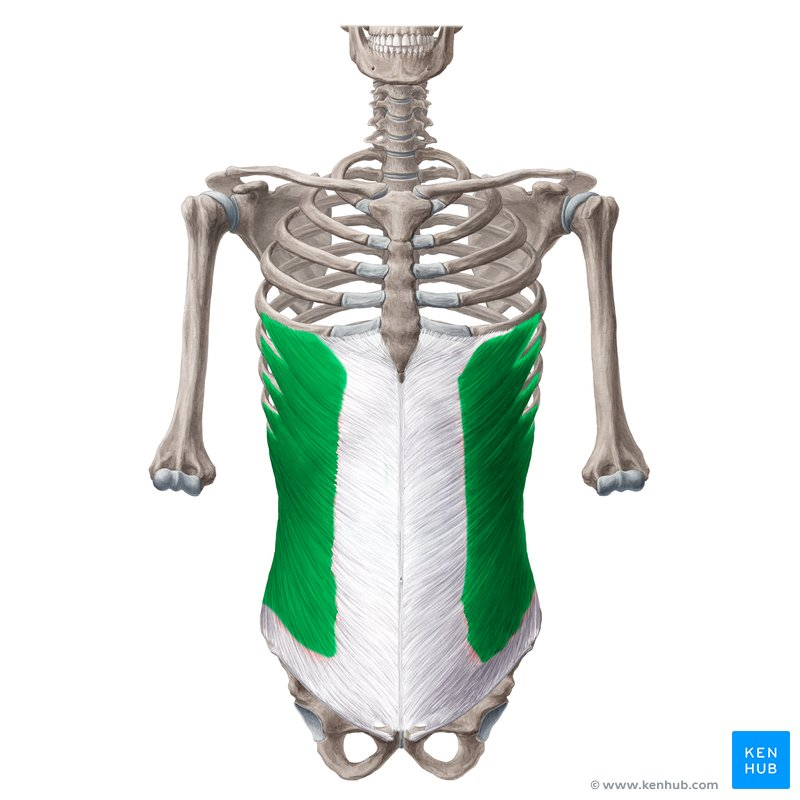
What muscle is highlighted in green? Where’s it origin and insertion? Also what innervation and action does it have?
external oblique
origin: external surfaces of ribs 5-12
insertion: linea alba and iliac crest
innervation: intercostal nerves 5-12
action: compresses and supports abdominal viscera, flexes and rotates trunk
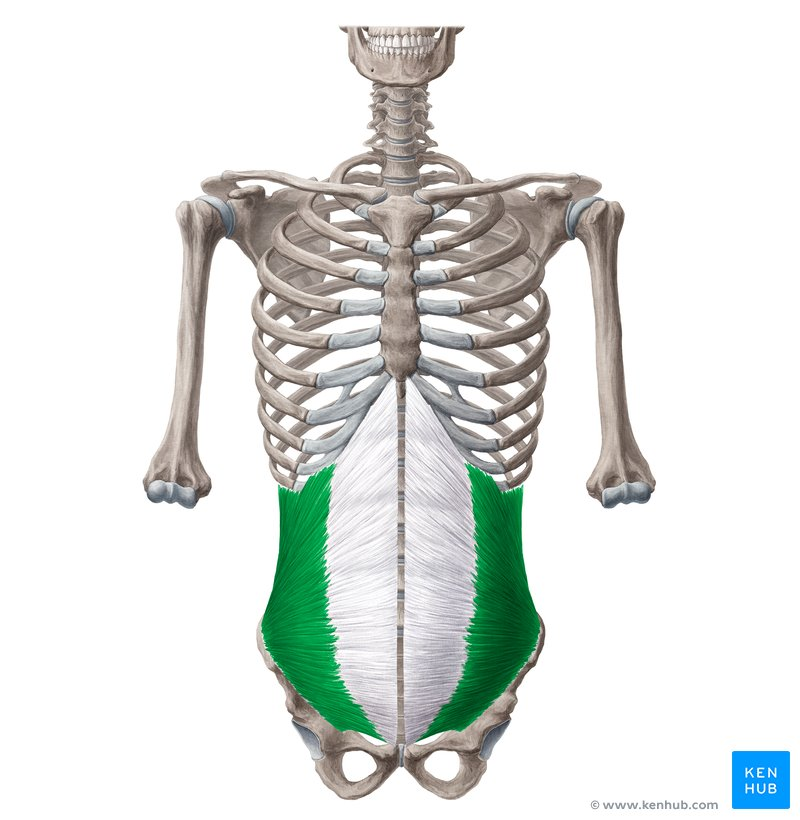
What muscle is highlighted in green? Where’s it origin and insertion? Also what innervation and action does it have?
internal oblique
origin: iliac crest
insertion: inferior borders of ribs 10-12, linea alba, pubis
innervation: intercostal nerves 5-12
action: compresses and supports abdominal viscera, flexes and rotates trunk
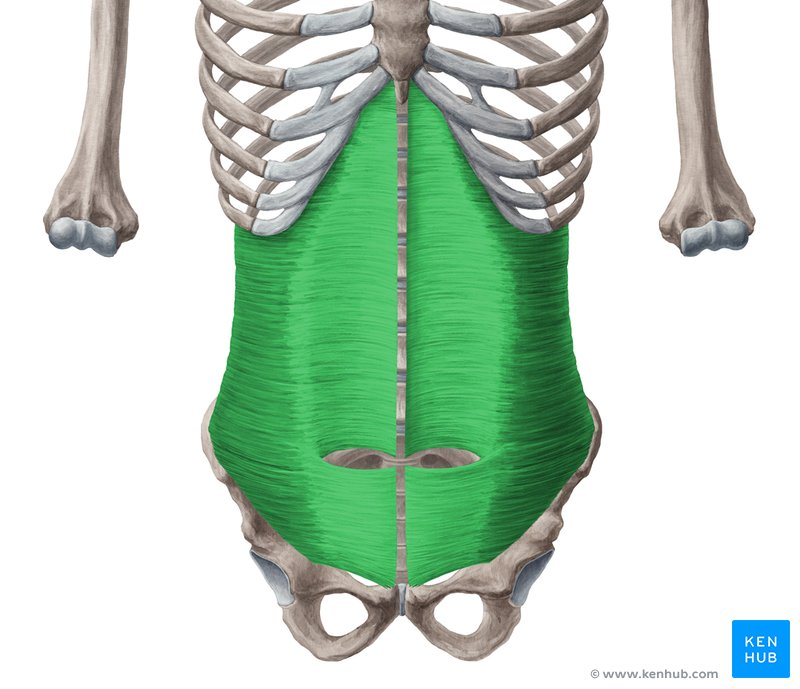
What muscle is highlighted in green? Where’s it origin and insertion? Also what innervation and action does it have?
transversus abdominis
origin: internal surfaces of costal cartilages 7-12, iliac crest
insertion: linea alba, pubic crest
innervation: intercostal nerves 5-12
action: compresses and supports abdominal viscera
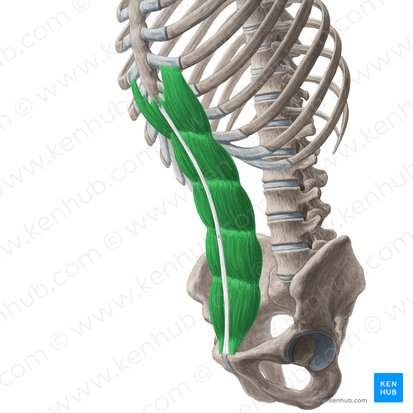
What muscle is highlighted in green? Where’s it origin and insertion? Also what innervation and action does it have?
rectus abdominus
origin: pubic symphysis, pubic crest
insertion: xiphoid process, costal cartilages 5-7
innervation: thoracic nerves (T7-T12)
action: flexes trunk, compresses abdominal viscera
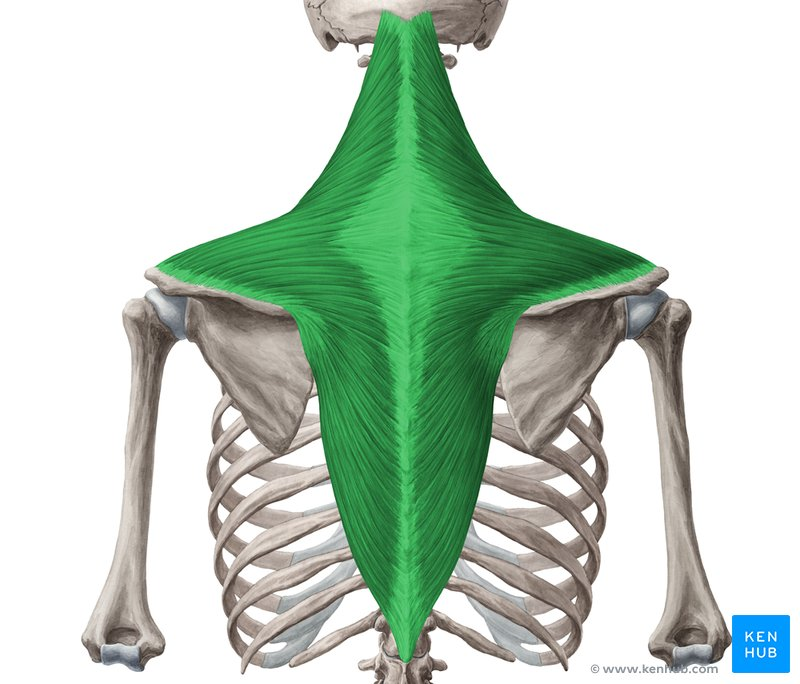
What muscle is highlighted in green? Where’s it origin and insertion? Also what innervation and action does it have?
trapezius
origin: occipital bone, spinous processes of C7-T12
insertion: lateral third of clavicle, acromion, spine of scapula
innervation: accessory nerve
action: elevates, retracts, and rotates scapula, lowers fibers —> depresses scapula
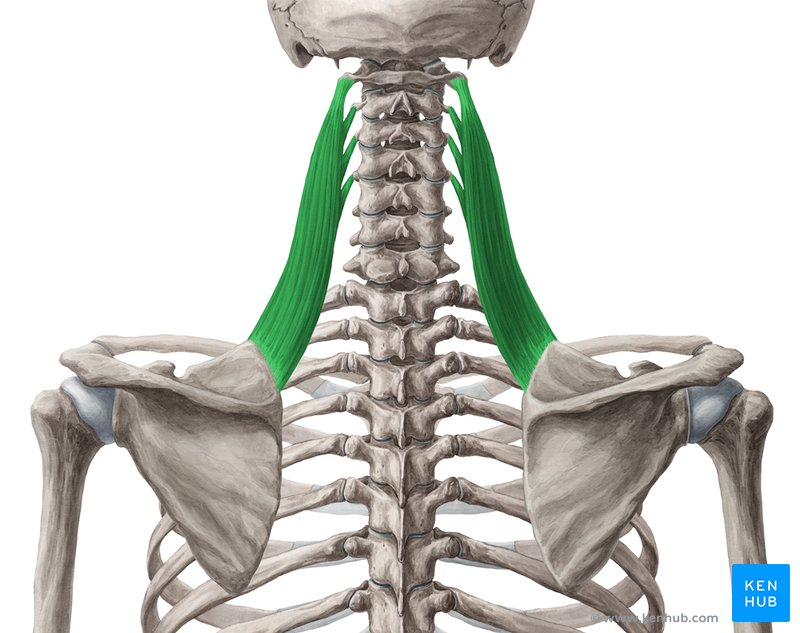
What muscle is highlighted in green? Where’s it origin and insertion? Also what innervation and action does it have?
levator scapulae
origin: transverse processes of C1-C4
insertion: medial border of scapula
innervation: C3-C4 and dorsal scapular nerve
action: elevates scapula medially, inferiorly rotates glenoid cavity
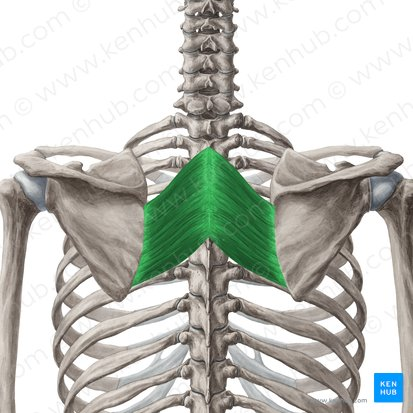
What muscle is highlighted in green? Where’s it origin and insertion? Also what innervation and action does it have?
Rhomboid major
origin: spinous processes of T2-T5 vertebrae
insertion: medial border of scapula
innervation: dorsal scapular nerve
action: adducts and inferior rotation of the scapula
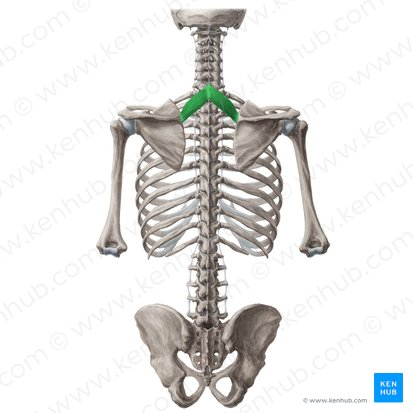
What muscle is highlighted in green? Where’s it origin and insertion? Also what innervation and action does it have?
rhomboid minor
origin: spinous processes of C7 and T1 vertebrae
insertion: medial border of scapula
innervation: dorsal scapular nerve
action: adducts and inferior rotation of the scapula
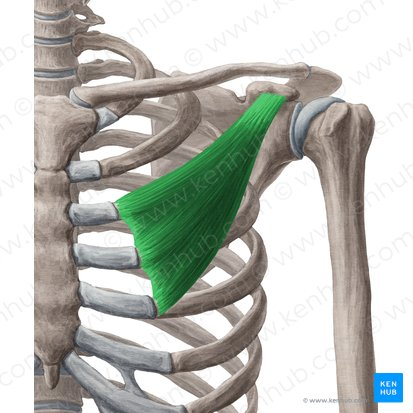
What muscle is highlighted in green? Where’s it origin and insertion? Also what innervation and action does it have?
pectoralis minor
origin: ribs 3-5
insertion: coracoid process of the scapula
innervation: medial pectoral nerve
action: lowers scapula and protracts shoulder
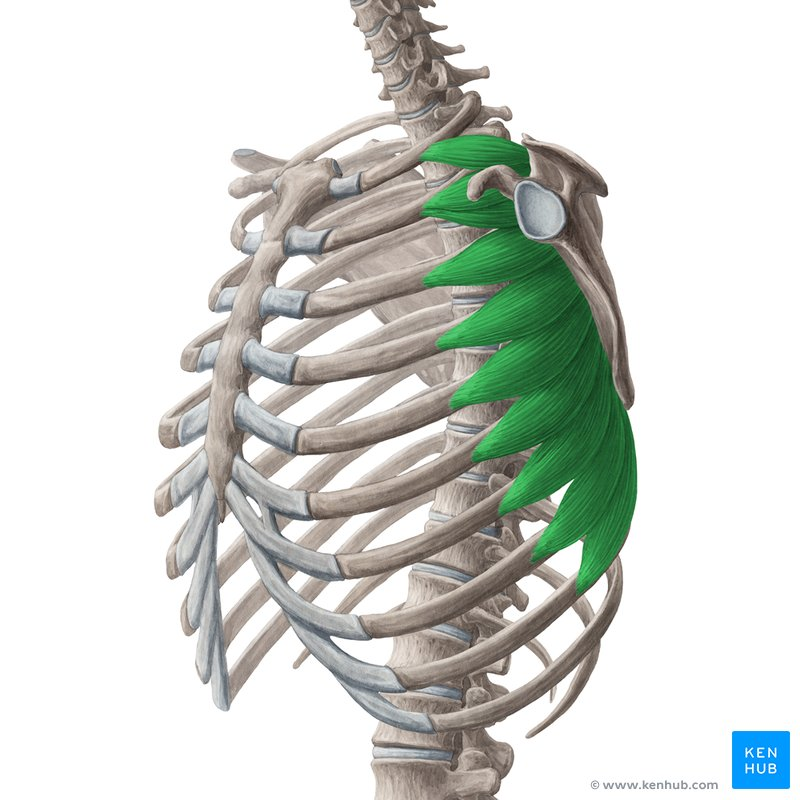
What muscle is highlighted in green? Where’s it origin and insertion? Also what innervation and action does it have?
serratus anterior
origin: first 9 ribs
insertion: medial border of scapula
innervation: long thoracic nerve
action: protracts shoulder and rotates scapula so the glenoid cavity moves superiorly
What are the muscles that make up the rotator cuff? Also, list their:
origin
insertion
innervation
action
Insertion at greater tubercle of humerus:
supraspinatus
origin: supraspinous fossa of scapula
innervation: suprascapular nerve
action: abduction at shoulder
infraspinatus
origin: infraaspinous fossa of scapula
innervation: suprascapular nerve
action: lateral rotation of shoulder
teres minor
origin: lateral border of scapula
innervation: axillary nerve
action: laterally rotate and adduction at the shoulder
subscapularis
origin: subscapular fossa
insertion: lesser tubercle of humerus
innervation: upper and lower subscapular nerves
action: medially rotates at the shoulder
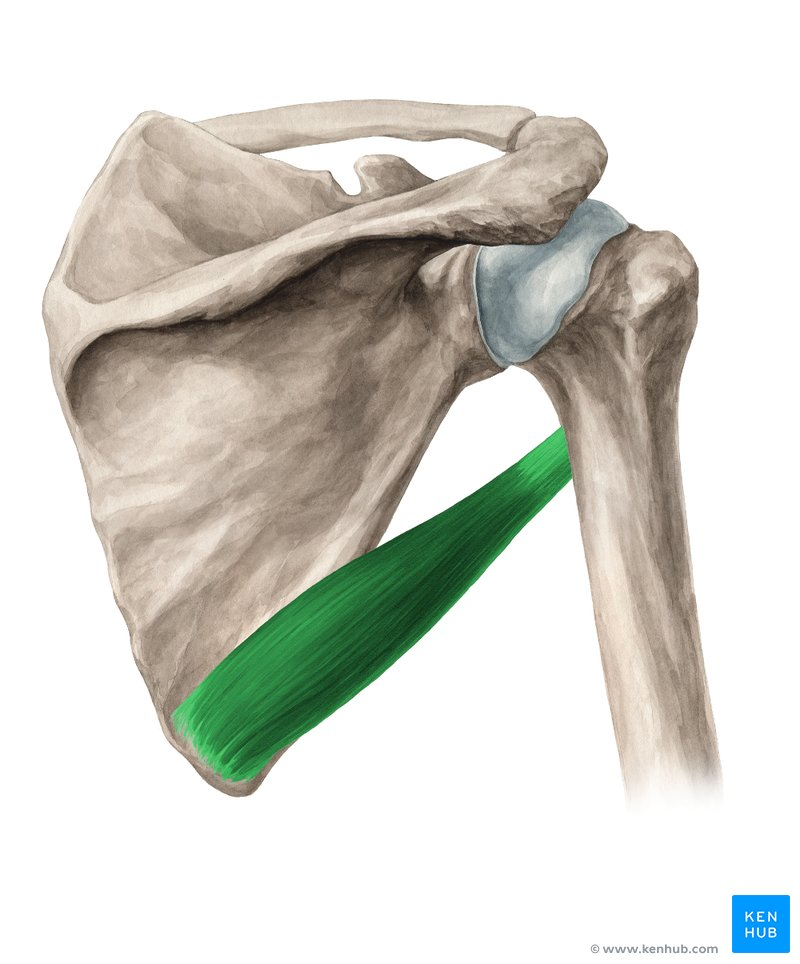
What muscle is highlighted in green? Where’s it origin and insertion? Also what innervation and action does it have?
teres major
origin: inferior angle of scapula
insertion: intertubercular sulcus of humerus
innervation: lower subscapular nerve
action: extension and medially rotation at the shoulder
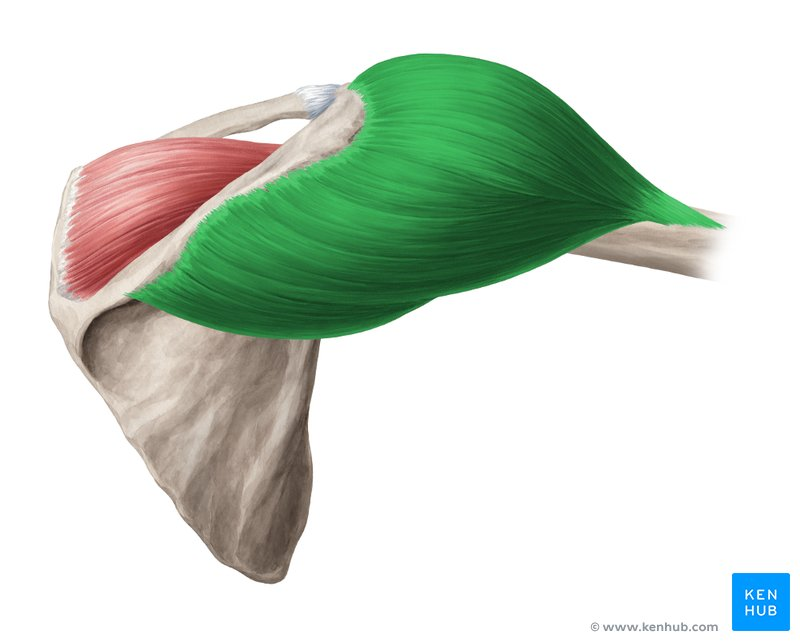
What muscle is highlighted in green? Where’s it origin and insertion? Also what innervation and action does it have?
deltoid
origin: anterior clavicle, acromion, spine of scapula
insertion: deltoid tuberosity of humerus
innervation: axillary nerve
action: whole muscle abduction at shoulder
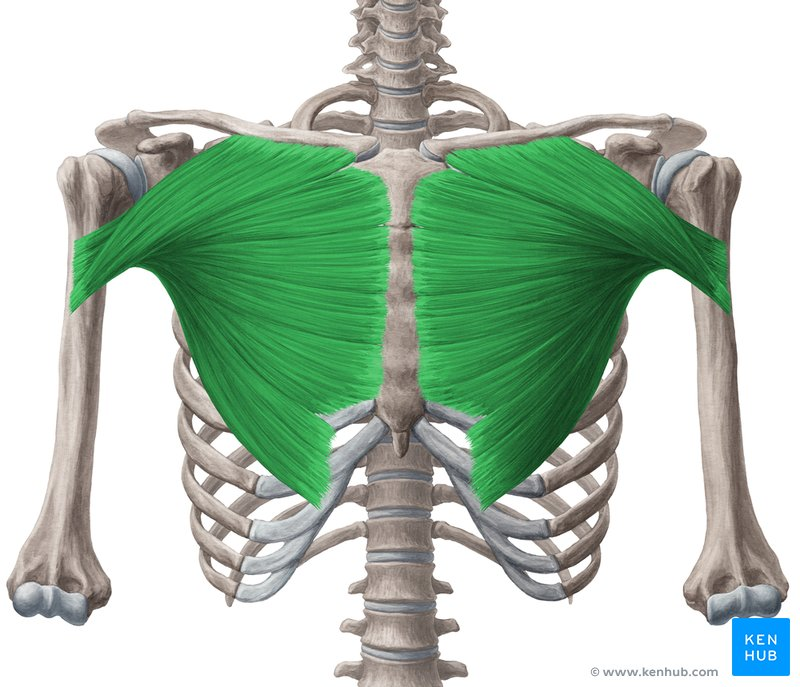
What muscle is highlighted in green? Where’s it origin and insertion? Also what innervation and action does it have?
pectoralis major
origin: sternal half of clavicle, sternum to 7th rib, cartilages of ribs 2-6
insertion: humerus (intertubercular sulcus)
innervation: medial and lateral pectoral nerves
action: flexes and adducts shoulder, rotates shoulder medially
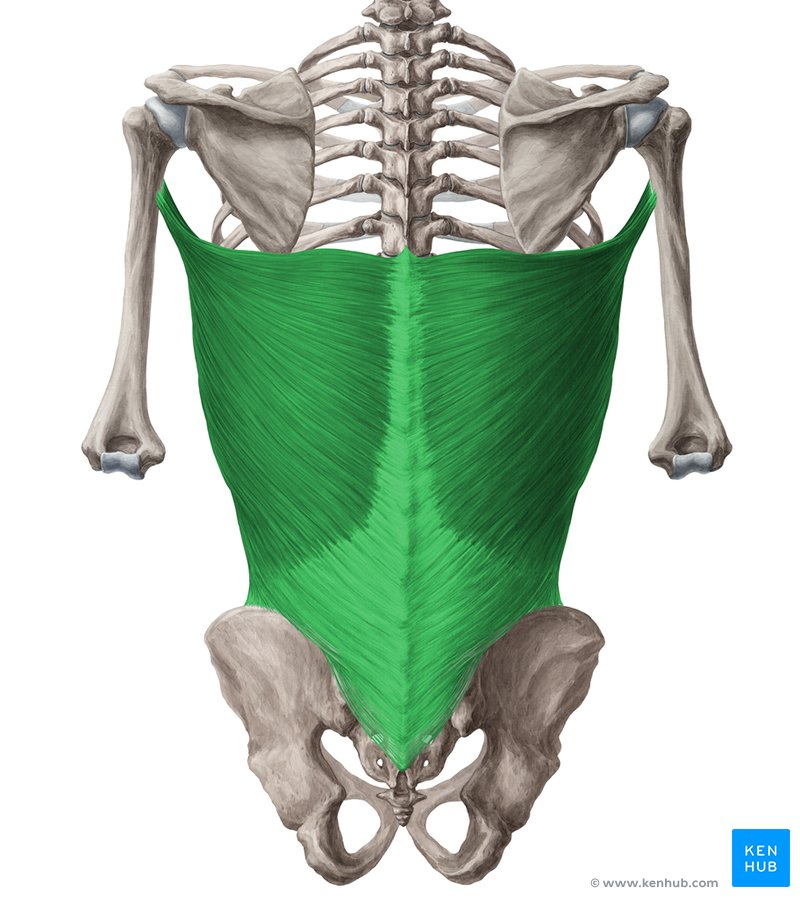
What muscle is highlighted in green? Where’s it origin and insertion? Also what innervation and action does it have?
latissimus dorsi
origin: spinous processes of T7-L5, iliac crest
insertion: humerus (intertubercular sulcus)
innervation: thoracodorsal nerve
action: extends, adducts, and medially rotates shoulder
What muscles have the innervation from the radial nerve and help the forearm move?
Include their:
origin
insertion
action
all of these muscles have innervation from the radial nerve AND help forearm move
brachioradialis
origin: lateral epicondyle of humerus
insertion: styloid process of radius
action: flexes forearm at elbow
triceps brachii lateral head
origin: superior lateral margin of humerus
insertion: olecranon process of ulna
action: extends forearm at elbow
triceps brachii long head
origin: scapula
insertion: olecranon process of ulna
action: extends forearm at elbow, extends and adducts arm at shoulder
triceps brachii medial head
origin: medial and posterior humerus
insertion: olecranon process of ulna
action: extends forearm at elbow
supinator
origin: lateral epicondyle of humerus
insertion: radius distal to the radial tuberosity
action: supinates forearm
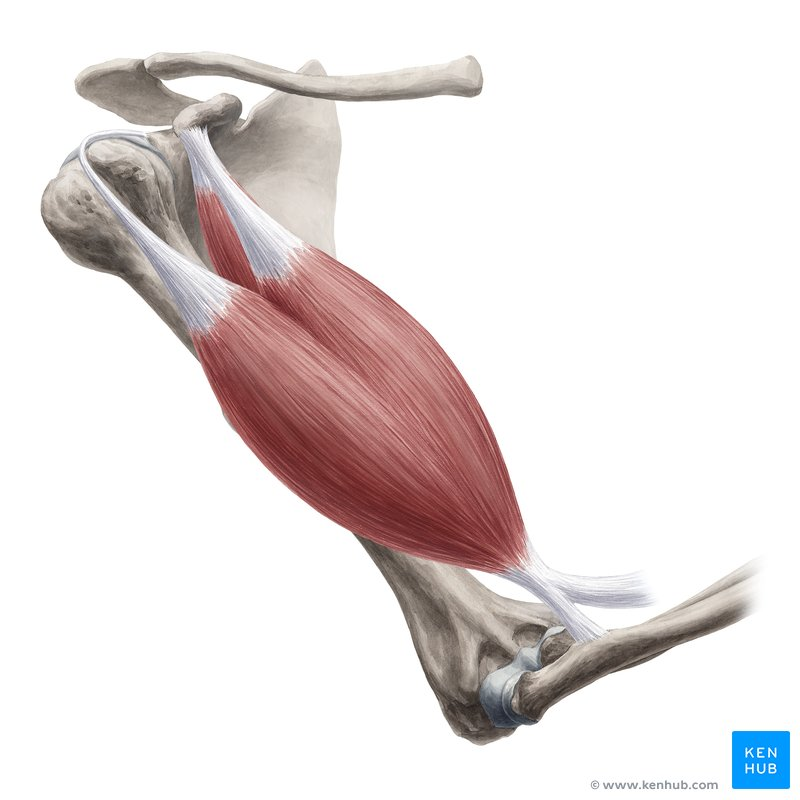
What muscle is shaded in red? Where’s it origin and insertion? Also what innervation and action does it have?
biceps brachii
origin:
long head: supraglenoid tubercle of scapula
short head: coracoid process of scapula
insertion: radial tuberosity
innervation: musculocutaneous nerve (C5, C6)
action: flexion at elbow and shoulder, supinates forearm at elbow
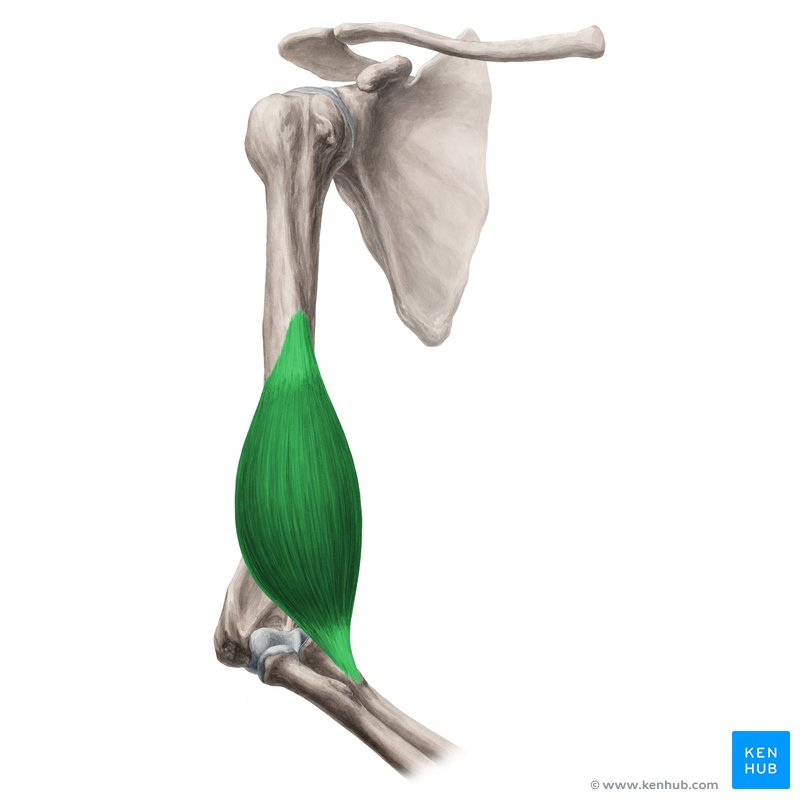
What muscle is highlighted in green? Where’s it origin and insertion? Also what innervation and action does it have?
brachialis
origin: anterior surface of humerus
insertion: coronoid process and tuberosity of ulna
innervation: musculocutaneous nerve and radial nerve (C7)
action: flexes forearm at elbow
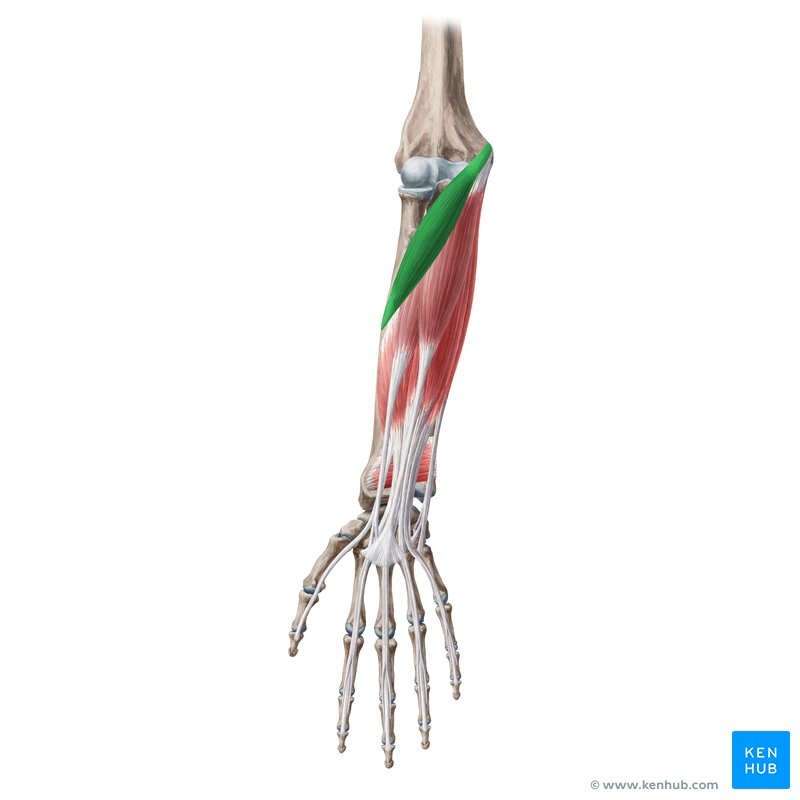
What muscle is highlighted in green? Where’s it origin and insertion? Also what innervation and action does it have?
pronator teres
origin:
medial epicondyle of humerus
coronoid process of ulna
insertion: lateral surface of radius
innervation: median nerve
action: pronates forearm and assists with elbow flexion
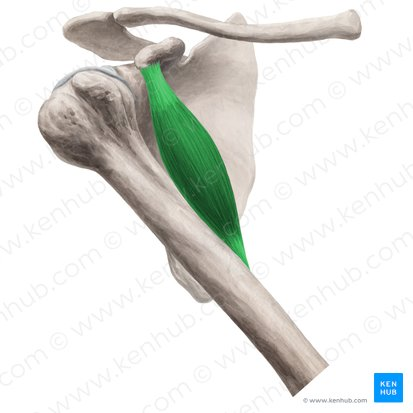
What muscle is highlighted in green? Where’s it origin and insertion? Also what innervation and action does it have?
coracobrachialis
origin: coracoid process of scapula
insertion: medial surface of humeru s
innervation: musculocutaneous nerve
action: flexes and adducts at shoulder
What muscles have the innervation from the radial nerve and help the wrist/fingers move?
Include their:
origin
insertion
action
all of these muscles have innervation from the radial nerve and help the wrist and fingers move
extensor carpi radialis longus
origin: humerus
insertion: 2nd metacarpal bone
action: extends and abducts hand at wrist
extensor carpi radialis brevis
origin: lateral epicondyle of humerus
insertion: base of 3rd metacarpal bone
action: extends and abducts hand at wrist
extensor digitorum
origin: lateral epicondyle of humerus
insertion: phalanges, digits 2-5
action: extends medial for digits, assists in wrist extension
extensor carpi ulnaris
origin: lateral epicondyle of humerus, ulna
insertion: 5th metacarpal
action: extends and adducts hand at wrist
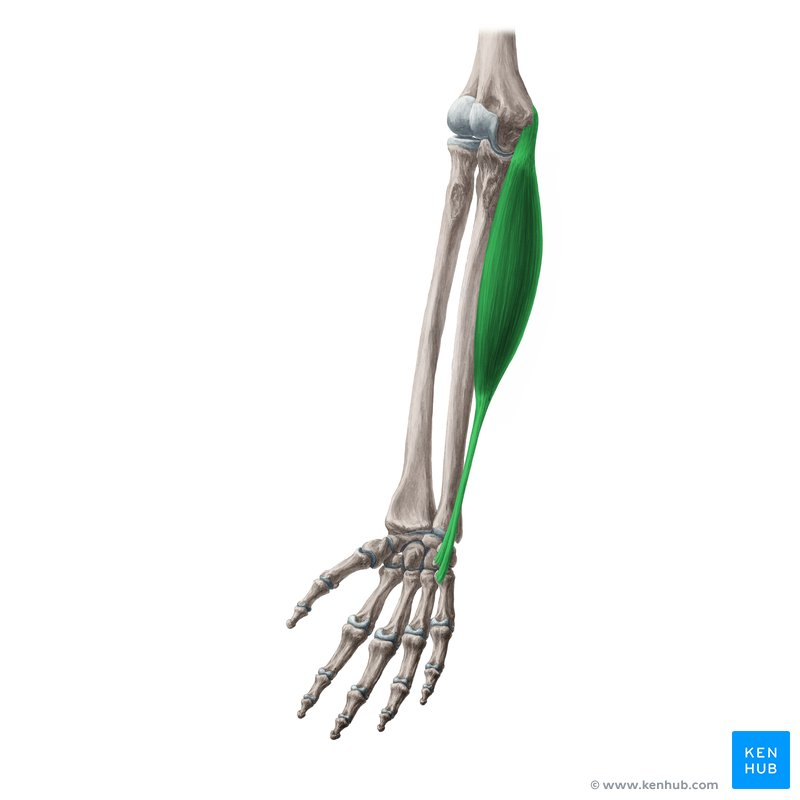
What muscle is highlighted in green? Where’s it origin and insertion? Also what innervation and action does it have?
flexor carpi ulnaris
origin: medial epicondyle of humerus, olecranon of ulna
insertion: pisiform bone, hamate, 5th metacarpal
innervation: ulnar nerve
action: flexes and adducts hand at wrist
What muscles are innervated by the median nerve and/or ulnar nerve?
Include their:
origin
insertion
action
innervated by median nerve:
flexor carpi radialis
origin: medial epicondyle of humerus
insertion: 2nd metacarpal
action: flexes and abducts hand at wrist
palmaris longus
origin: medial epicondyle of humerus
insertion: none
action: flexes hand at wrist
flexor digitorum superficialis
origin: medial epicondyle of humerus, and coronoid process of ulna
insertion: middle phalanges 2-5 digits
action: flexes middle and proximal phalanges, flexes hand at wrist
Innervated by ulnar nerve:
flexor carpi ulnaris
origin: medial epicondyle of humerus, olecranon of ulna
insertion: pisiform bone, hamate, 5th metacarpal
action: flexes and adducts hand at wrist
innervated by both:
flexor digitorum profundus
origin: none
insertion: none
innervation:
medial part: ulnar nerve
lateral part: median nerve
action: flexes distal phalanges of digits 2-5, assists with flexion of hand at wrist
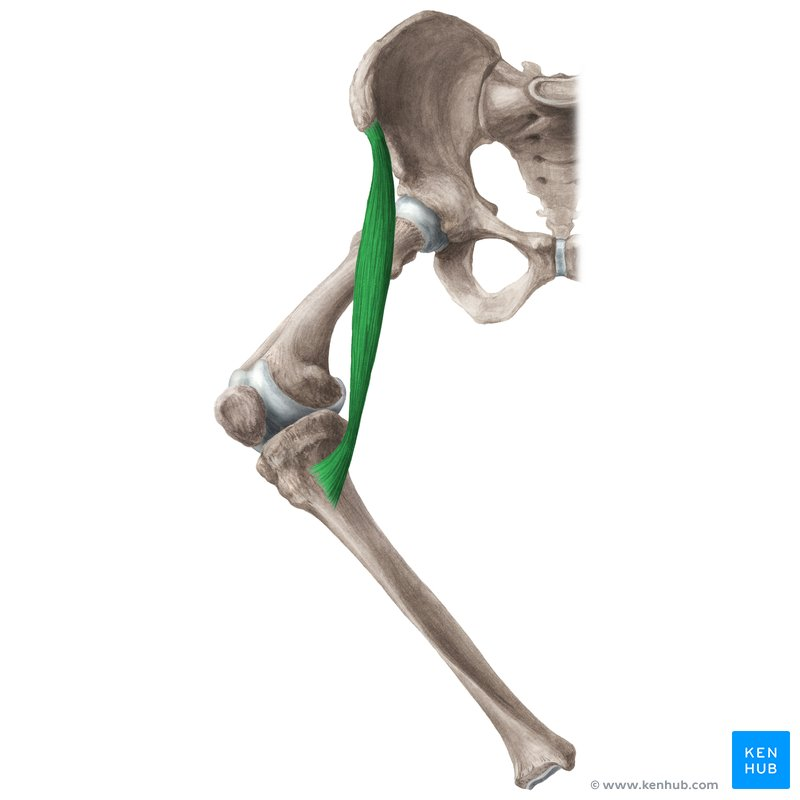
What muscle is highlighted in green? Where’s it origin and insertion? Also what innervation and action does it have?
sartorius
origin: anterior superior iliac spine
insertion: tibial tuberosity
innervation: femoral nerve
actions: abducts, laterally rotates, and flexes at hip, flexes knee joint
What muscles are innervated by the obturator nerve and/or sciatic nerve
Include their:
origin
insertion
action
innervated by obturator nerve:
gracilis
origin: inferior ramus of pubis
insertion: medial condyle of tibia
action: adducts and medially roates hip, flexes and medially rotates at knee
adductor longus
origin: body of pubis inferior to pubic crest
insertion: linea aspera of femur
action: adducts thigh at hip
innervated by obturator and sciatic nerves:
adductor magnus
origin: inferior pubic ramus, ramus of ischium
insertion: linea aspera, femur
action: whole muscle adduction at hip
What muscles are innervated by the superior gluteal nerve?
Include their:
origin
insertion
action
tensor fasciae latae
origin: anterior superior iliac spine and iliac crest
insertion: iliotibial tract
actions: abducts, medially rotates and flexes thigh at hip
gluteus medius:
origin: anterior iliac crest, lateral surface of ilium
insertion: greater trochanter of femur
action: abduction and medially rotates at hips
gluteus minimus:
origin: lateral surface of ilium
insertion: greater trochanter of femur
abduction and medially rotates at hips
What muscles are innervated by the inferior gluteal nerve?
Include their:
origin
insertion
action
gluteus maximus
origin: ilium, sacrum, and coccyx
insertion: iliotibial tract and gluteal tuberosity of femur
action: extension and lateral rotation at hip
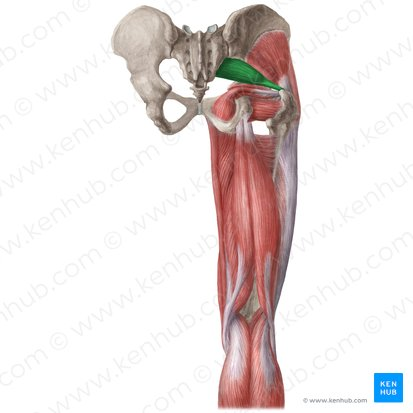
What muscle is highlighted in green? Where’s it origin and insertion? Also what innervation and action does it have?
piriformis
origin: sacrum
insertion: greater trochanter femur
innervation: none
action: none
What muscles make up the illopsoas group and what action do they perform?
iliacus and psoas major work together to do hip flexion
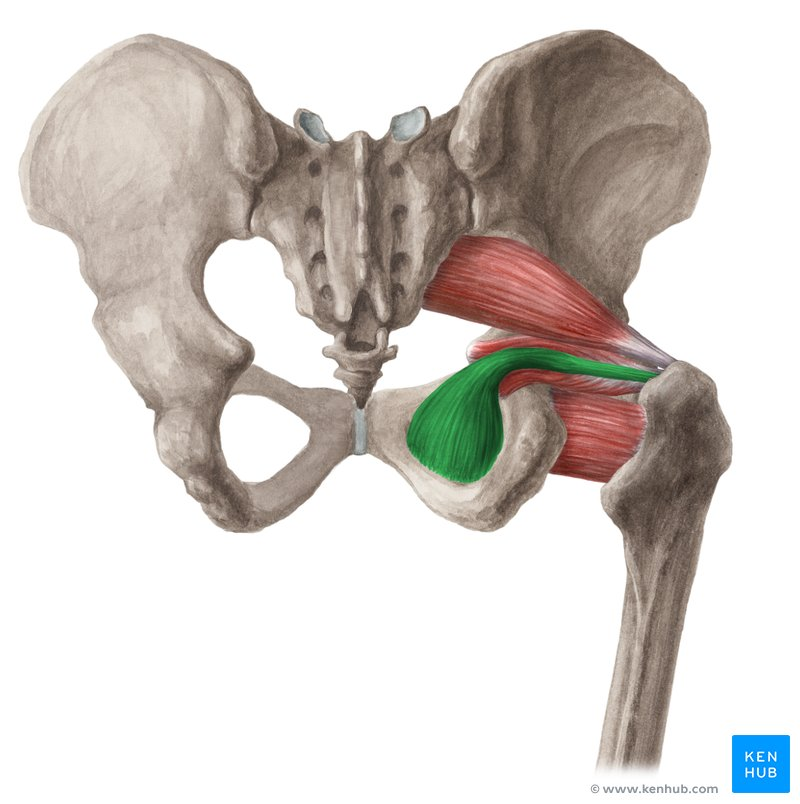
What muscle is highlighted in green? Where’s it origin and insertion? Also what innervation and action does it have?
obturator internis
origin: none
insertion: none
innervation: none
action: laterally rotation and abduction at hip
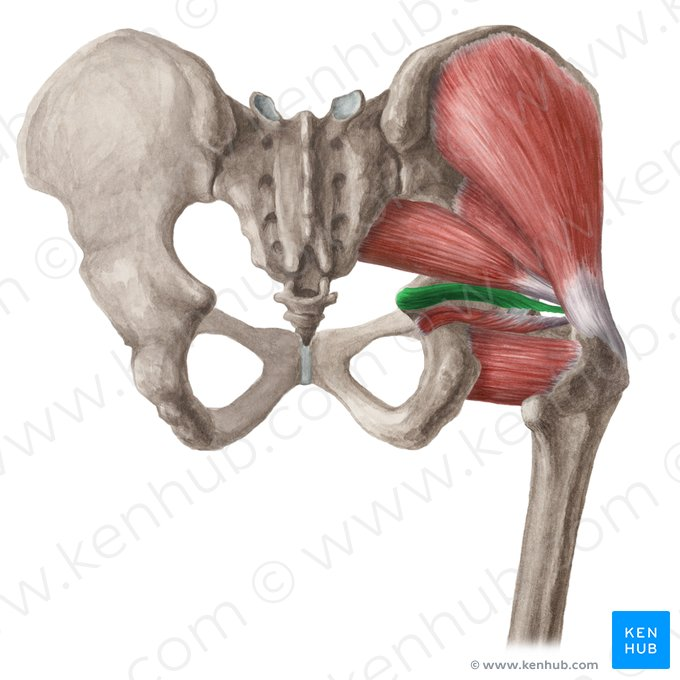
What muscle is highlighted in green and the one below it? Where’s it origin and insertion? Also what innervation and action does it have?
superior gemmelii and inferior gemmelii
origin: none
insertion: none
innervation: none
action: laterally rotation and abduction at hip
What muscles are innervated by ONLY the sciatic nerve and they allow for flexion at the knee?
Include their:
origin
insertion
other action(s)
biceps femoris
origin: ischial tuberosity
insertion: head of fibula, lateral condyle of tibia
action: also extension and lateral rotation at hip
semitendinosus
origin: ischial tuberosity
insertion: medial surface of tibia
action: also extension and medial rotation at hip
semimembranosus
origin: ischial tuberosity
insertion: medial condyle of tibia
action: also extension and medial rotation at hip
What muscles are innervated by the femoral nerve?
Include their:
origin
insertion
action
vastus medialis:
origin: linea aspera of femur
insertion: patella and tibial tuberosity
action: extension at knee joint
vastus intermedius
origin: anterior femur and linea aspera (distal half)
insertion: patella and tibial tuberosity
action: extension at knee joint
vastus lateralis:
origin: greater trochanter, linea aspera of femur
insertion: patella and tibial tuberosity
action: extension at knee joint
rectus femoris:
origin: anterior inferior iliac spine of ilium
insertion: base of patella, tibial tuberosity
action: extension at knee and flexion at hip
What muscles are innervated by the deep fibular nerve?
Include their:
origin
insertion
action
tibialis anterior:
origin: lateral condyle, proximal tibia
insertion: 1st metatarsal bone and medial cuneiform
action: dorsiflexes foot at ankle and inverts foot
extensor digitorum:
origin: lateral condyle of tibia
insertion: phalanges digits 2-5
action: extends toes 2-5 and dorsiflexes foot at ankle
What muscles are innervated by the superficial fibular nerve?
Include their:
origin
insertion
action
peroneus (fibularis) longus:
origin: head and proximal shaft fibula
insertion: 1st metatarsal and medial cuneiform
action: eversion of foot, plantar flexes foot at ankle
peroneus (fibularis) brevis:
origin: distal fibula
insertion: 5th metatarsal bone
action: eversion of foot, plantar flexes foot at ankle
What muscles are innervated by the tibial nerve?
Include their:
origin
insertion
action
gastrocnemius
origin: femoral condyles
insertion: calcaneus
action: plantar flexes foot at ankle joint, flexion of knee joint
soleus:
origin: head and shaft of fibula
insertion: calcaneus
action: plantar flexes foot at ankle, postural muscle when standing
plantaris
origin: femur
insertion: posterior calcaneus
action: plantar flexes foot at ankle joint, flexion of knee joint
flexor digitorum longus:
origin: posterior tibia
insertion: distal phalanges 2-5
action: flexes toes 2-5 and plantar flexes foot at ankle